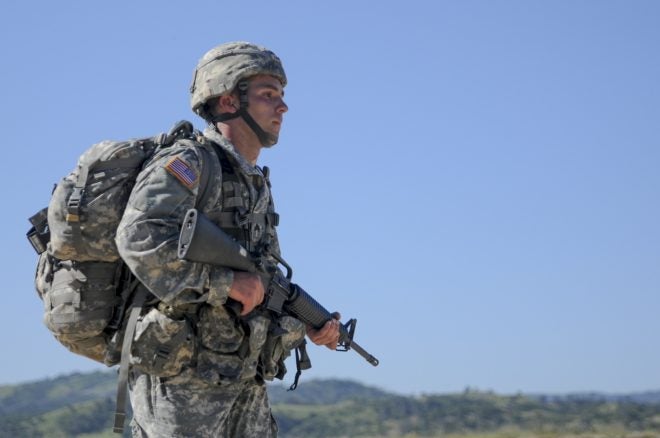In his testimony before Congress on Thursday, Army Chief of Staff General Mark Milley put forth a concerning picture of the readiness of the United States Army: Soldier readiness is below half that of the Army’s goal, and tens of thousands of soldiers are reportedly non-deployable, many of them permanently. The reason for this state of affairs is medical – Milley testified that 90% of non-deployable soldiers were out for medical reasons, with most of those being orthopedic. According to Milley, 20,000 non-deployables (over 2% of the total personnel in the Army) have been assigned permanent non-deployable status and are being processed through the Integrated Disability Evaluation System (IDES). A portion of Chief Milley’s conversation with Senator Jack Reed is transcribed below:
Reed: “General Milley, Army readiness, uh, Brigade Combat Teams, as I understand that now, is roughly 30%, is that a fair judgement about the readiness status?”
Milley: “Roger, that’s correct. The exact readiness I’d be happy to brief you or your staffs – it’s classified – but as an order of magnitude, sure.”
Reed: “Sure, we’re in that ballpark.”
Milley: “And the goal of course is 66%.”
Reed: “66%. And what are the two or three key steps that you have to take, you think, to get from where it is today to that 66%?”
Milley: “Yeah, there’s several of them, but the long, the most significant right now, the drag, if you will, is manning. Many of these units are not at the full manning level, and that drags down their readiness, in terms of the reporting system we have. But also in terms of going out to training and/or deployment. So if a unit would have a significant amount of non-deployables, though we’ve dropped that number by two
thirds over the last 5 years, but there’s still a significant amount of non-deployables, so if we fill units at 95%, and we have 10% non-deployables it takes you to 85%, you take away the day-to-day grind, you’re down to 80% or less that goes out to training. That is not a good thing. You should at least be 90-95% when you go out to training, you go to the Combat Training Center. So manning is the critical drag
on the system. We have made improvements because of the money you gave us in terms of spare parts and maintaining the equipment better, so that’s a good news story there, but the manning has continued to drag. So with the Authorization ’17 to take us to 476, what we want to do is make the existing force structure whole, there are some minor force structure increases in this budget request, but we want to make the force structure that does exist complete, whole, and fully ready, before we move on to the next step which is expanding the Army.”Reed: “And, in that regard, I understand 10% of the non-deployable personnel are non-deployable for medical reasons.”
Milley: “About 85-90%, actually are medical, the rest of them are legal and other reasons.”
Reed: “And how are you trying to get at that? Is there something in terms of enhanced training or lifestyle or anything else? That seems to be a significant problem.”
Milley: “Yeah, the majority of those are orthopedic-type injuries. Most are recoverable with some extended profiles. So they are non-deployable in the short term. Total Army, out of the million-plus troops, about 20,000 – about 2% or so – are hard down; they’ll never be able to deploy. And those we’re working through the IDES system, and the number of days it takes to process them has come down from well over a year in the 370s-390s in the range of days, we’ve got it down by a hundred days to 270, so we’re trying to chip that away so that reduces the number of permanent non-deployables down and the VA then picks up their care. There’s several things we have to do internal to the organization.”
Reed: “One of the things I assume you have to do is improve recruitment and retention. In order to get to your – just to fill up the current existing force structure, is that accurate?”
Milley: “Our recruitment and retention are, at this point, meeting the goals. Last year we had 100% across the board, to date this year we’re about 80% or so for recruitment, and about 75% to date – of course the year’s not finished yet – on retention. With the increase in end-strength authorization to 476, we significantly increased the recruiting and retention missions. I think we’ll be within 1%, plus or minus of achieving that by 1 October.”
The figures Milley quotes do not seem to be much changed versus reports from this time last year, which quoted a figure of approximately 100,000 non-deployable soldiers in the Army. If that is still the case, it would mean that almost a tenth of the Army is unable to fight due to medical reasons. Milley did report, however, that the rate of non-deployables has been cut by 2/3rds over the past five years, likely substantially due to rotation of soldiers since the scaling back of US involvement in Iraq and Afghanistan.
What this seems to indicate is that the injury rate for the average soldier in the Army is too high, creating a severe readiness problem. How could the injury rate be reduced? Possible methods include better physical conditioning, better medical oversight for Army units, and a reduced soldier load.
 Your Privacy Choices
Your Privacy Choices
